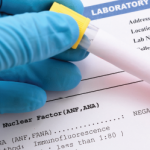Clinical & Research Relevance

Dr. Choi
Dr. Choi advises rheumatologists to learn early on, in detail, how a laboratory conducts and reports results from ANA testing and specifically what type of assays are used. For example, ANA screening that doesn’t detect CMP patterns could potentially miss the presence of anti-ribosomal P, an antibody often considered a key biomarker for neuropsychiatric lupus and lupus hepatitis, she says.
A misclassification could also make it difficult for a patient to qualify for a clinical trial if the physician suspects lupus but the lab results are negative for ANA. This is relevant now more than ever because of new European League Against Rheumatism/ACR classification criterion that requires a lupus patient to be ANA positive, says Dr. Choi.
“It’s really important that when a rheumatologist is ordering these tests to understand what exactly their ANA is telling them,” she says, adding it’s also important to know how the lab reports it.
The authors note a changing spectrum of ANAs is evolving to include CMPs. This development has led to a debate about whether to change the terminology to “anti-cellular antibodies” to address the increasing clinical relevance of CMPs.
“I think it’s going to be very hard to move away from the (ANA) terminology because historically that’s what everyone has been calling it,” says Dr. Choi “It technically makes more sense to call it anti-
cellular now, just because it makes it clearer that we are looking at the whole cell, not just the nucleus.”
Meanwhile, the International Consensus on Antinuclear Antibody Patterns Committee considered a reclassification of ANA to include CMPs, but ultimately decided to delay action on the matter, recognizing that current criteria are predicated on a more traditional definition, according to the article.
What’s Next
The authors foresee a decrease in the prevalence of anti-cellular antibody-negative lupus to correspond with a shift in emerging nomenclature guidelines toward including non-nuclear patterns in ANA reporting.
“I think the prevalence of true ANA-negative lupus is quite uncommon … .” says Dr. Choi. “As labs report cytoplasmic patterns and mitotic patterns to be ANA positive that number … will continue to go down.”
Dr. Choi and her colleagues plan a follow-up study with the same cohort to investigate whether patient ANA should be tested not solely in the beginning to diagnose lupus but also throughout the course of the disease.
“We are looking at all these patients again and repeating their serologies on multiple assays to compare the performance of the ANAs in each of these assays,” says Dr. Choi.
“We’re going to take a look at what a lupus patient’s ANA does over their disease course and whether that is affected by things like medication and disease activity,” she says “The hope is that this will provide more information to the rheumatologists so that when they order the ANA test, they can better interpret what the test means.”

